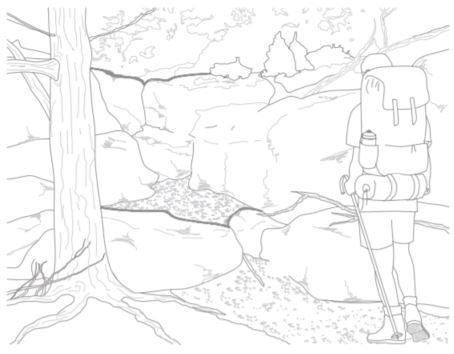Outdoor Developed Areas: A Summary of Accessibility Standards for Federal Outdoor Developed Areas
Conditions for Exceptions
Conditions for Exceptions [1019]
The ABA Standards recognize the existence of constraints and limitations in the outdoor environment and allow for exceptions from specific provisions in the technical requirements where certain circumstances, referred to as “conditions for exceptions,” apply. When an entity determines that any of the conditions for exceptions do not permit full compliance with a specific provision in the technical requirements, compliance with that provision is required to the extent practicable. The phrase “to the extent practicable” means reasonably doable under the circumstances.
The conditions for exceptions should be used only after all other design options are thoroughly explored. Where a condition for exception applies to only part of a trail, a beach access route, or an outdoor recreation access route, the rest of the trail or route must comply with all the technical requirements for the trail or route.
The following sections describe the four conditions for exceptions and provide examples of situations where they might apply.

Condition for Exception 1
Compliance is not practicable due to terrain. The phrase “not practicable” means not reasonably doable.
For example, where a trail is constructed in a steeply sloped area, compliance with the running slope provision may not be practicable on parts of the trail where it would require extensive cuts or fills that are difficult to construct and maintain, cause drainage and erosion problems, significantly lengthen the trail, and create other adverse environmental impacts.
Condition for Exception 2
Compliance cannot be accomplished with the prevailing construction practices.
This condition does not require the use of construction equipment or methods other than those typically used in a particular type of setting.
For example, where handtools would normally be used to construct a trail in order to minimize the impact on a sensitive adjacent stream and the prevailing construction practices for this type of setting do not include blasting, blasting does not have to be used to remove a rock outcrop in order to comply with the clear tread width provision. Compliance with the clear tread width provision is required to the extent that it can be accomplished using handtools.
Prevailing construction practices are those used by most contractors or designers faced with the same or similar projects in the area. Preferences or practices used by a single contractor or designer are not necessarily prevailing construction practices.
Condition for Exception 3
Compliance would fundamentally alter the function or purpose of the facility or the setting.
This condition recognizes that public lands provide a wide variety of recreational experiences, from highly developed areas to wilderness areas that appear unchanged from primeval times and provide opportunities for people to experience primitive and challenging conditions. The condition applies where compliance with specific provisions in the technical requirements would fundamentally alter the function or purpose of the facility or the setting.
For example, people using primitive trails experience the outdoor environment in a nearly natural state, with limited or no development. Use of manufactured building materials or engineered construction techniques to comply with specific provisions in the technical requirements for trails could fundamentally alter the natural or undeveloped nature of the setting and change the recreational experience. Trails that are intended to provide a rugged experience, such as a cross-country training trail with a steep grade, a fitness challenge course with abrupt and severe changes in elevation, and a trail that traverses boulders and rock outcroppings to provide users with the opportunity to climb the rocks, are other examples. To remove the obstacles on these trails or to reroute the trails around the obstacles would fundamentally alter the function or purpose of the trails.
Condition for Exception 4
Compliance is limited or precluded by any of the following laws, or by decisions or opinions issued or agreements executed pursuant to any of the following laws:
-
Endangered Species Act (16 U.S.C. §§ 1531 et seq.)
-
National Environmental Policy Act (42 U.S.C. §§ 4321 et seq.)
-
National Historic Preservation Act (16 U.S.C. §§ 470 et seq.)
-
Wilderness Act (16 U.S.C. §§ 1131 et seq.)
-
Other Federal, State, or local law, the purpose of which is to preserve threatened or endangered species; the environment; or archaeological, cultural, historical, or other significant natural features
The laws specified in this condition prescribe certain activities or require certain analyses to be prepared or procedures to be followed when planning projects that may impact features protected under the laws. The condition does not require full compliance with a specific provision in the technical requirements where compliance is limited or precluded by the laws, or by decisions or opinions issued or agreements executed pursuant to the laws.
Example
Situations where the condition may apply include:
-
Congressionally designated wilderness areas. The condition applies if work that is necessary to comply with a specific provision in the technical requirements can’t be accomplished using handtools, because motorized equipment is prohibited by law in Congressionally designated wilderness areas.
-
Designated wetlands or coastal areas where construction methods and materials are limited.
-
Tribal sacred sites where the physically undisturbed condition of the land is an important part of the sacred observance.
-
Areas where water crossings are restricted to safeguard aquatic features protected under Federal or State laws.
Archaeological and cultural features include burial grounds and cemeteries, protected tribal sites, and other properties considered sacred by an organized religion. Historical features are properties listed or eligible for listing on the National Register of Historic Places or other places of recognized historic value. Significant natural features include objects, such as large boulders, rocky outcrops, and bodies of water; or unique trees or vegetation, such as giant sequoia groves, that are regarded as distinctive or important locally, regionally, or nationally and are therefore placed under legal protection.
Table 1 summarizes the conditions for exceptions and when and where they may apply.
| Table 1— Permissible Uses of Conditions for Exceptions | ||
| Technical Requirements | Specific Provisions | Applies To |
| Outdoor constructed features | Clear ground space | Alterations only |
| Tent pads and tent platforms | Any specific provision | New construction or alterations |
| Camp shelters | Any specific provision | New construction or alterations |
| Outdoor recreation access routes at camping facilities, picnic facilities, and trailheads | Any specific provision | Alterations only |
| Viewing areas | Any specific provision | Alterations only |
| Outdoor recreation access routes to viewing areas | Any specific provision | New construction or alterations |
| Trails | Any specific provision | New construction or alterations |
| Beach access routes | Any specific provision | New construction or alterations |
Documenting Use of the Conditions for Exceptions on a Portion of a Trail or Beach Access Route [F204.4.1]

When using the conditions for exceptions on a portion of trail or a beach access route, Federal agencies should document in writing why they could not fully comply with a specific provision in the technical requirements for trails or beach access routes. The documentation should be retained with the project records. The documentation should include the date the decision is made and the names and positions of the people making the decision. The Access Board is responsible for investigating complaints alleging violations of the ABA Standards and will request documentation when a complaint involves a trail or beach access route.
Exemptions for an Entire Trail or Beach Access Route [1017.1, Exception 2 and 1018.1, Exception 2]
When extreme or numerous conditions for exceptions make it impractical to construct a trail or beach access route that complies with the technical requirements, the ABA Standards provide an exemption for the entire trail or beach access route. The exemption for an entire trail or beach access route can only be used after applying the conditions for exceptions to portions of the trail or beach access route. When determining whether to exempt an entire trail or beach access route, consider the portions of the trail or beach access route that can and cannot comply with the specific provisions in the technical requirements and the extent of compliance where full compliance cannot be achieved.
Notifying the Access Board When an Entire Trail or Beach Access Route is Exempted [F204.4.1]
In the rare cases where an entire trail or beach access route is exempted, Federal agencies must notify the Access Board about the exemption. Sample notification forms are in the appendix of this guide and are also available on the Access Board’s Web site at www.access-board.gov/guidelines-and -standards/recreation-facilities/outdoor-developed-areas/final-guidelines -for-outdoor-developed-areas/notification-forms. Federal agencies do not have to obtain approval from the Access Board to exempt an entire trail or beach access route. The Access Board will monitor the use of exemptions for an entire trail or beach access route and may provide additional guidance on the use of such exemptions. Federal agencies are encouraged to seek technical assistance from the Access Board when considering exempting an entire trail or beach access route.

User Comments/Questions
Add Comment/Question